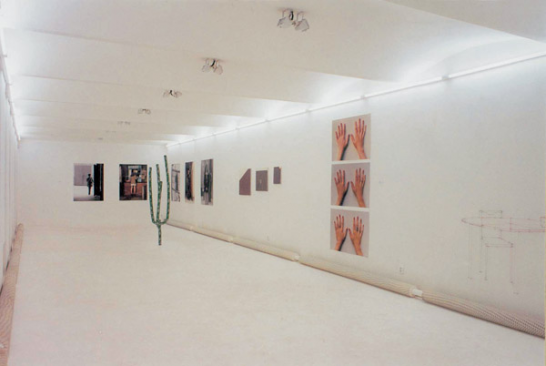| Zeitschrift Umělec 2003/2 >> Futura o. s. | Übersicht aller Ausgaben | ||||||||||||
|
|||||||||||||
Futura o. s.Zeitschrift Umělec 2003/201.02.2003 Mariana Serranová | neuigkeiten | en cs |
|||||||||||||
|
In the low-budget Czech landscape, new Futura Gallery has made a truly adrenaline-pumping impact. During the take-off of everything new, the stories surrounding unfettered projects are always full of optimism, and big hope. In the case of Futura, it is necessary to figure in the fact that, at a time when Czech galleries and artistic operations are not exactly suffering from a surfeit of money, any large successful initiative becomes even more visible. Futura stands out in peacock feathers. In terms of program structuring and financing, no precedent exists in Prague. The start-up of HOME Gallery in December last year was the last positive boost to hit the art scene. But what basically sets Futura apart from other galleries is its ambition to be a functioning “centre for contemporary art” with wider aims than just being an exhibition space.
The initiator of Futura is program director Marisa Přihodová, who has been on the Czech art scene for a number of years and has to her credit a series of successful projects. Auspicious connections brought her together with her Italian partners, Alberto di Stefano and Eugenio Percossi, who have helped to provide the gallery its indispensable financial base. Thanks to this, it became possible to reconstruct the space in Smíchov at fantastic speed. The last member of the talented team is Camille Hunt, who focuses on the business side of the venture. In October last year the team set up a syndicate and began to seek out spaces for the location for a non-profit making art complex. The main prerequisite, of course, was the financing: Futura’s costs make great claims on its sponsors, something that was mediated mainly by Alberto Di Stefano. Currently Futura is aiming to gain support from the state and the EU. Futura is different from other galleries in the vehemence with which it promotes public accessibility and easy-access, “barrierless” partnerships with other galleries and organizations. From its long list of honorable objectives, one of the most interesting is the creation of an on-line database to store files on artists of all ages and generations, thus making it easier to find references. The possibilities to be explored in operating a three-floor gallery are truly exciting. It’s 800 square meters of exhibition space has no equal in Prague. By comparison, for instance, the space available to show work in Home Gallery is a healthy 180 square meters, but the basement corridors and the total segmentation of Futura allow for a more playful composition of installations, and greater comfort for visitors in the ground-floor gallery, where a coffee shop and bookshop will open in the autumn, in co-operation with the English bookshop Anagram. This summer Futura launched its first summer residency in the chateau in Třebešice (Kutná Hora, CZ) with three artists from Holland. Images on the website show vast light-filled spaces in crumbly buildings, some of which have been reconstructed. In the future the organizers wish to invite both Czech and foreign artists to take up residence there. According to Přihodová, unlike the residence organized by the Foundation and Center for Contemporary Art in Jelení, the Třebešice chateau residencies, in terms of organization and bureaucracy, will be less institutionalized. Futura’s debut contemporary art exhibition on June 27, 2003, titled Survey ‘03, was curated by Karel Císař, who was ruminating on the context of the Prague biennial and strove to introduce a multi-generational cross-section of 20 contemporary Czech artists. His concept was very kindly accepted, and with David Černý making the most of the Knížák-Klaus theme, Futura was watched from the beginning with eager eyes. Another crowd drawer has been the surprising exhibition of new paintings by Jiří David and the video work of the Swedish artist Annika Larson, both currently on display. What comes next is still a secret. However, in the future expect co-operation with galleries, curators and artists from Italy, Holland and the USA, as well as continued dialogue with domestic institutions and individuals, and of course large events. “The gallery’s program does not wish to limit itself only to the presentation of art,” says Přihodová. “We’re presenting more than just art. We will also hold film showing, lectures, performances, readings, small concerts.” The ideal of the gallery team is to create a kind of broad “community” founded on the widest possible co-operation, she says. “People are still saying that we’re a gallery. We’re much more than that.” The new emerging space, whose all-embracing and generous program is open to all, is just now establishing its profile, but with it’s open-handed approach and supple fingers, accomplishing its plans can only benefit the Czech cultural scene. Galerie Futura Holečkova 49, Prague 5, Smíchov Open Wed – Sun, 12 p.m. – 7 p.m., free entry More at www.futuraprojekt.com www.mainouverte.com Now on: Jiří David, Sober-Minded (new paintings) / Annika Larson, Dog (Video 2001) and Poliisi (Video 2001) (11.9. – 2. 11. 2003)
01.02.2003
Empfohlene Artikel
|
|||||||||||||







Kommentar
Der Artikel ist bisher nicht kommentiert wordenNeuen Kommentar einfügen